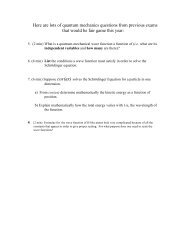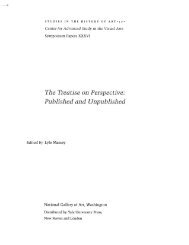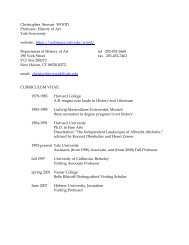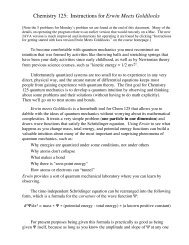Chemistry 125 First Examination Answer Key (preliminary ...
Chemistry 125 First Examination Answer Key (preliminary ...
Chemistry 125 First Examination Answer Key (preliminary ...
You also want an ePaper? Increase the reach of your titles
YUMPU automatically turns print PDFs into web optimized ePapers that Google loves.
<strong>Chemistry</strong> <strong>125</strong><strong>First</strong> <strong>Examination</strong> <strong>Answer</strong> <strong>Key</strong> (<strong>preliminary</strong>)September 28, 2007 Mean Score 72.9 (1/3 > 79 ; 2/3 > 70)The exam budgets 50 minutes, but you may have 60 minutes to finish it. Good answers can fit in the space provided.Question values correspond to alloted time. Don't waste too much time on cheap questions.Read each question carefully to see what it asks for (bold face is used to help highlight questions).Make sure you are answering the question, not just saying something vaguely relevant to its topic.1. The following structure is commonly drawn for theantihistamine Benadryl. This structure is misleading,because the HCl reacts with the organic molecule to formwhat used to be considered a “pentavalent” atom.Cl _ammonium+ H[George Rieveschl, the organicchemist who invented Benadrylat the age of 26 in the early1940s, died the day before thisexam. See NYTimes obituarySept. 29, 2007.etherA) (4 min) Scratch out the HCl and redraw its atoms to showa proper Lewis structure with lines for bonds. Write afew words to help explain the “pentavalence.”phenylphenylThe fourth bond from N to H, is formed by N’s sharing its unshared pair of electrons with the protonfrom HCl. This gives the N a formal + charge, which causes it to attract chloride through an ionic bond.From the point of view of 19 th Century chemists, before G. N. Lewis, this made normally trivalent Npentavalent.B) (3 min) Circle and name each functional group in your improved structure of Benadryl.2. (4 min) Draw bond lines and necessary formal charges among the atoms below to show the two most reasonable“resonance structures” for formamide. Draw the proper arrow symbol between the two structures.OO_HCNHHHCH+NHO+[Later on we’ll see that the seemingly implausible resonance structure shown in redis neither negligible nor very important. It has complete octets, but weird charges]HC_NHH
Chem <strong>125</strong> <strong>First</strong> Hour Exam <strong>Answer</strong> <strong>Key</strong> 9/28/07 Page 23. (2.5 min) Who said "I cannot bear the Thought of being made Master of a Jewell I know not how to wear”?What did he mean?Samuel Pepys wrote this in a letter to Isaac Newton to explain why he wanted to learn to make acalculation himself, rather than just accepting the answer from Newton. He wanted to be able to solveother related problems. He wanted to know why.4. (2.5 min) Why did J. J. Thomson propose that negative corpuscles (or electrons) were arranged INSIDE a cloudof positive charge density?Earnshaw’s Theorem showed that a set of particles interacting through inverse-square forces (likeCoulomb’s Law) could not have a stable structure for separated particles. By having the negativeparticles inside the positively charge cloud, it was possible to have structures (which he hoped wouldexplain periodicity).5. (3 minutes) Explain how a discovery by Chladni relates to the idea of “degenerate” orbital energies.Chladni observed that vibrational modes with different patterns could give the same vibrationalfrequency (pitch). In the same way, wave functions for one-electron atoms with the same principalquantum number (n), but different combinations of nodal surfaces, can yield the same energy.A key feature of this question was degeneracy (note the bold face), which some answers did notaddress.[Note that Chladni was VERY far from knowing anything about electrons, since he died in 1827, andelectrons weren’t discovered until 1895. He did acoustics, but the waves that were involved, especially3-dimensional ones, proved analogous to Schroedinger’s wave functions of 1926.It is interesting that there is no degeneracy in one dimension (only one way to get nodes, e.g. onepoint for one node), and less degeneracy in 2-dimensions (one circle or one line for one node), than in 3-dimensions (one sphere or any of three different planes for one node).]6. (5 minutes) How and Why does one hybridize atomic orbitals? Explain using the example of an H-like atom inan electric field.Hybrid orbitals are a weighted sum of hydrogen-like orbitals for a single atom. They arecreated to provide a simple approximation to the wave functions that would result from a potential that ismore complicated than simple coulombic attraction to a single nucleus. (They have the advantage ofpreserving the virtues of the shape of the pure H-like orbitals in cases where attraction to the nucleusprovides the most important part of the potential energy – especially when the orbitals being combined,or mixed, that is added, are degenerate, i.e. have the same principal quantum number.)For example, when one imposes an electric field on an H atom, it will not move, because it has nooverall charge, but it will distort with the nucleus shifting one way and the electron cloud shifting theopposite way. Adding a 2p function (which is positive on one side of the nucleus and negative on theother) to a 2s function (which has the same sign on both sides) gives a new function which is larger onone side than on the other. This the electron cloud is shifted off-center. (This extension is maximum for50:50 mixing of 2p with 2s.)[A number of answers failed to address the second part of the question about the electric field.I am sorry that so many people failed to see that a hybrid orbital results from simple addition of twonormal H-like orbitals on the same atom. Perhaps the lecture was unclear; if so, it is a pity that no wikiwas prepared on this topic to help clarify the situation.]
Chem <strong>125</strong> <strong>First</strong> Hour Exam <strong>Answer</strong> <strong>Key</strong> 9/28/07 Page 45. The diagram is part of an “Erwin Meets Goldilocks”plot with two trial wave functions for the potentialenergy, which is shown in gray.A) (2 min) Draw a horizontal line showing theTOTAL ENERGY for the ψ curve that becomeshorizontal at the right. Be as accurate as you can.(Intersect PE curve below inflection points)B) (2 min) Is the total energy for the other trial ψ(the one that has a value of 0 at the right) higheror lower than that the one you drew in A?Explain your thinking.The second trial ψ curves more stronglytoward the baseline, this means that ithas a somewhat higher total energy thanthe first.Total EnergyC) (3 min) Assuming that this is a Hooke’s Law single-minimum problem, draw in the correct lowest-energyψ function (NOT its energy), and extend all three ψ curves to the right edge of the page.D) (5 min) Now assume that this potential is in fact the left half of a symmetric double minimum, and the original twoψ traces are part of correct solutions. Explain how one ψ may be considered “bonding”, and the other“antibonding”.The upper curve has less curvature toward the baseline than the single-minimum red curve, andtherefore less energy. So a particle described by this wave function of the double-minimum potential haslower total energy than it would have in the lowest-energy function of the single minimum. That meansthat the situation with the minima separated from one another, so that they behave independently andhave the energy of the single-minimum situation, is of higher energy than the situation where they areclose together. Since it requires energy to separate the minima, they can be said to be bound together,and the wavefunction can be considered “bonding”.The lower curve has more curvature toward the baseline than the single-minimum red curve, andtherefore more energy. By an analogous argument, this function can be said to be “antibonding”.[Note that the question of “bonding” provides a great illustration of the importance of “Compared towhat?” To see that there is a reason for bonding we need to compare the energy of the wave functionfor the double minimum to the energy for corresponding wave function for the single minimum (whichis the same as when the two minima are very far apart). This shows that there is an energetic bias infavor of the minima being close together, that is, they are bonded with regard to the lowest-energy wavefunction. Vice versa for the higher-energy wave function of the double minimum.]



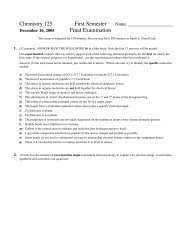
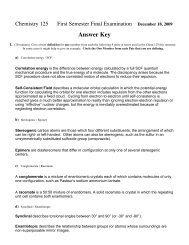
![Review: [untitled] Author(s): Christopher S. Wood ... - Yale University](https://img.yumpu.com/47633680/1/184x260/review-untitled-authors-christopher-s-wood-yale-university.jpg?quality=85)

